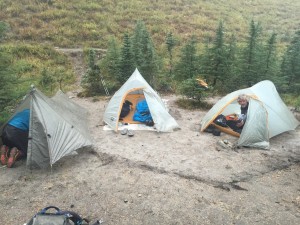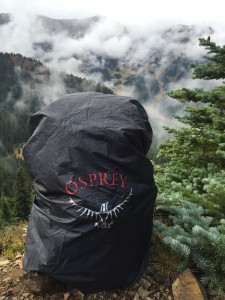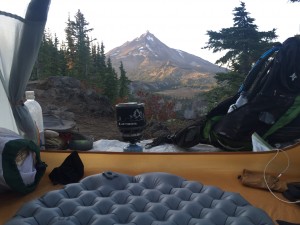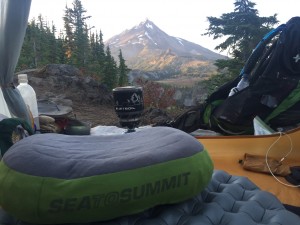Now that the journey is complete, in reflection, below is the final list of equipment that I used on the hike. My final thoughts about the hike will follow soon.
Tent – Big Agnes Fly Creek 2
I started the hike with a light weight quilt and tarp (each weighed 9 ounces) I thought this would work fine for my travel through the desert, little did I know how cold it would get at night. The wind blowing through the tarp (you can’t stop some wind from blowing through the ends) would suck the warmth right out of the quilt. I was really cold every night. The quilt with a tent may work or a bag with a tarp may be OK but not the tarp, quilt combo.
I found this tent to be lightweight, (2 lbs.) easy to set up and take down, spacious, durable (held up in snow, rain, and high winds), didn’t leak, and kept the wind out. It has a great mosquito net top which disappeared at night which made for great bug free star gazing.
Backpack – Osprey EOS 48
I can’t say enough good things about this pack or the folks at Osprey. This pack was the perfect size, the mesh suspension system that holds the back of the pack away from your back was great for cooling, and very comfortable. It is simple, lightweight and durable, but unlike many Ultra lite packs it had a very strong suspension system and enough storage areas to keep your smaller gear organized. 1/2 way through the hike I manage to damage some straps and mesh pockets. They replaced the pack no problem and even sent the brand new pack to my next resupply stop on the trail. The Osprey guys rock. Just for the record I had intended to do the hike with a Ultimate Directions Fast Pack 30. When I loaded all of my gear in the 30 I found I could get everything to fit but not a bit of extra room. I was concerned that when I needed to carry 8 liters of water or more food, I would exceed the reasonable capacity of the pack. But thanks to Buzz Burell for letting me give it a try.
Sleeping Bag – Sea to Summit Talis 2
As I said above, the tarp just didn’t work. This bag was warm, lightweight, with waterproof down. I feel, for several reasons this is the best bag I could have used on this hike. It was light (right at 2 lbs.) super durable, never got wet (very water resistant) and in the northwest this was critical and rated to 17 degrees. It stuffed really small in its compression sack and would loft up nice and fluffy every night no matter what the conditions.
Sleeping Pad – Sea 2 Summit
After sleeping on the ground for 5 months straight, sometimes on rocks, snow or rain soaked vegetation, I found that I preferred sleeping on an air mat rather than foam. The problem with an air mat, like the Neo Air that I started with, is the constant concern for getting a puncture. Sea to Summit has addressed this concern with their new dual inflation system. It is built with a two layered construction and each sides inflates independently which means if you get a puncture on one side you still sleep on what feels like a fully inflated mat. I found this mat to be lightweight, quick to inflate with a simple to use inflation bag that doubles as a pack liner. It deflates instantly through the over sized valves. It was quiet and very comfortable to sleep on it.
Pillow – Sea 2 Summit
A pillow may sound a little superfluous when you are counting every ounce but it turned out to be a critical piece of equipment. A good nights sleep is so very important. The inflatable Sea to Summit pillow was super compact, lightweight and comfortable (had to repair a couple of times).
Stove – Jetboil Mini Mo
Although it was a little heavier than the alcohol stove I started with, the few extra ounces were so worth it. It heats quickly, super-efficient (uses very little fuel), adjustable flame that will simmer as well as blaze, and is a good size with an integrated lightweight pot. If you plan on carrying a stove (many did not, we called them soakers) this was the most popular option out there.
Ground Sheet
Tyvek house wrap. I noticed some people carrying a sheet of super light-weight plastic, (it looked like saran-wrap) This option offers no protection from sharp stones or sticks, tears easy and did not last. I finished with the same sheet of tyvek that I started with and even gave it to a South Bounder on my last night. Lightweight, durable and cheap, enough said.
Headlamp – Black Diamond
I was up every morning at 4:45am and on those new moon dark nights a headlamp was pretty handy. If you find yourself camped around others having a red light option is nice so you don’t wake your fellow hikers. The Black Diamond was super light, easy “swipe on swipe off” controls and had great battery life.
Water Filtration – Sawyer Squeeze Filter
With some equipment I was lucky and chose the right gear before I left, others I learned by observing what worked well for others. in the case of the Sawyer Filter, this is the water filtration I used from the start and the only one I saw others using as well. The water in the desert was pretty sketch and really needed to be filtered. Once I hit the Sierra I was able to use springs for most of my drinking water and didn’t filter much.
Water Containers
2 one-liter bottles + a 2-liter “Camel back” bladder in backpack
On day one you have a 20 mile dry section. Most people carried 8 liters of water (16 lbs.) that first day. I think that was the last time I carried that much water for the rest of the trip. Even for the longest dry sections of the desert I never carried more than 4 liters, 2 in my pack bladder and 2 one liter smart water bottles, one with the Sawyer filter attached.
Outer Wear
Rain Gear – Marmot jacket and rain pants. It is tough to hump rain gear through the desert when your sweating your ass off, but I got more snow, rain and freezing winds in the desert than anywhere on the trail. The gear I took was very waterproof, lightweight and durable. Pants are important to offer protection form wet foliage or poison oak etc..
T-shirt – Ice breaker Morino Wool . Yes, even in the desert wool is great.
Columbia Insect Blocker lightweight hoody – worked like a charm against mosquitoes
Exofficio and North Face zip-off pants (or running shorts and tights)
Silk long underwear tops and bottoms – mostly for sleeping only
Puffy Down jacket – lightweight (whole trip)
Puffy Down vest – lightweight (whole trip)
Wool hat (great for sleeping)
Gloves – waterproof, and light weight
Sun hat – full brim or Saraha-style breathable hat for sun protection, a ball cap is ok but you’ll burn your ears.
Socks – 6 pairs of lightweight wool socks. It is important to change your socks constantly! (sometimes twice a day) Foot problems will end your trip faster than any other physical issue. I found Darn Tough Socks ($20 each, but carry a lifetime guarantee) to be the most common and in my opinion the best.
Shoes – 1 pair for hiking, Crocs for camp shoe. I went through 6 pairs, most of them were Altra, Lone Peak 2.0. I also used 2 pair of Hokas – Uppers were not durable and offered very little lateral stability. Brookes Cascadia’s were also very popular on the trail. I also used a Hans Wag Hiking Shoe for snowy parts of the Sierras with micro-spikes.
Other Stuff
Hiking Poles – Cooperdale is what I used , any will do but you will want to bring them for sure. It is best to have poles with adjustable with clips (not twist). You will need new pole tips, just buy they en route. 90% of PCT hikers had poles.
Swiss Army knife – very small, lightweight with tweezers, toothpick, scissors, knife
Tenacious Tape – repairs down
Superglue –Good to use for small cuts as well.
Needle/thread – Best treatment for blisters, leave the thread in to drain the blister.
Tape wrapped on a ski pole – duct tape or athletic tape
Backpacker umbrella (silver) Great for sun or rain.
Phone, charging system – 1 battery pack with charger (no solar) I did almost all of my navigation with apps on my phone
Apps – PCT, Guthook, North American peak finder
Paper half-mile maps – area map
Toiletries
- Benedryl – bee stings
- Ibuprofin – calms leg jerks when your trying to sleep
- Toothbrush, toothpaste
- Baby wipes, doesn’t weigh that much but cleans better than TP.
- Small amount of toilet paper
- Bug repellent small amount
- Sunscreen
- Lip balm
- Foot care – mole skin, bandaids, neosporin
Bear Canister
This was required on the JMT and through Yousmite. I ditch the canister after I left the park . Bought the larger one and stored more than just my food in it.
Over Packed?
At some point I realized I had over packed. So what would I do differently?
- Too many clothes (1 of each only)
- Too much extra fuel. One canister at a time and burn it down.
- Extra food too often. If it’s 100 miles to the next resupply, than carry 5 days of food and arrive empty, don’t carry 6 or 7 days if it isn’t necessary.
- Too much extra water. Check to determine where the next water source is and carry the amount necessary to get there. Water is heavy so carry what you need but no more. I would often arrive at the next water source with more than a liter of water in my pack.
- Solar panel. If you manage your phone use you don’t really need to carry a panel. Take a spare battery and fully charge your phone and battery at the resupply. If you manage your phone use it will last for more than a week. Leave the panel at home.
Lessons Learned
It’s not a race! It is easy to get caught up in others energy of “how many miles did you do today”? Where and when is my next resupply? I need to rush, rush, rush. If rushing through this experience is all you are thinking about than you have missed the whole point of being there. Don’t compare your progress to others, hike your own hike. Your in the most beautiful place in the world, fully embrace it.






Awesome Dean. I love reading about the gear and recommendations. Thanks for the follow through!
Thanks, very interesting,
Good Luck
Nice peace, send it to all the outdoor, recreational and hiking magazines, Eddie Bauer, Cabelas, etc.
good info, thanks Dean.
Interesting Dean. I’m sure others will find your info invaluable.
Thanks for the info Dean!!
What did you use to store your food in the first 700 miles to Kennedy meadows.
At night how did you protect your food from the resident critters? Inside outside your tent ?..
what were the critters that were interested in your food?
With this gear list what was your base weight?
The sea to summit sleeping pad which one did you use?
Dean all your posts and info are so helpful. You and I are about the same age and my plan is to hike all of the California sections beginning May 2017. You are an inspiration to us sixty years old dudes.
Randy Wallace